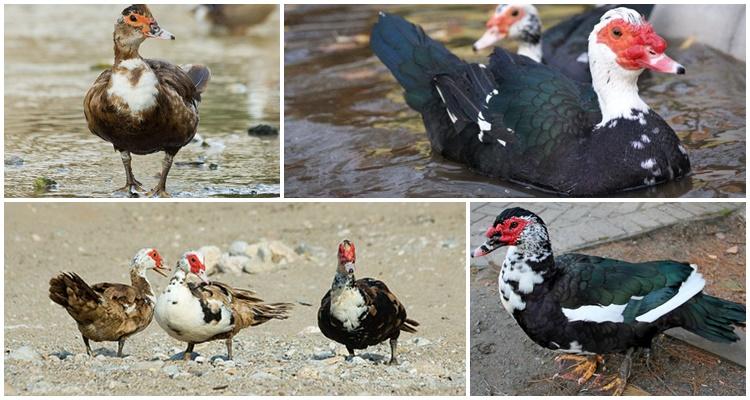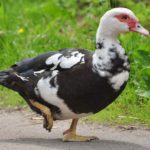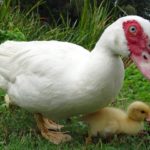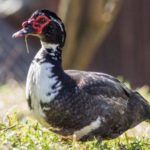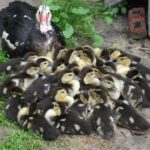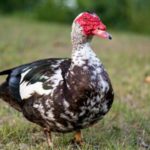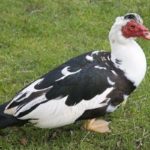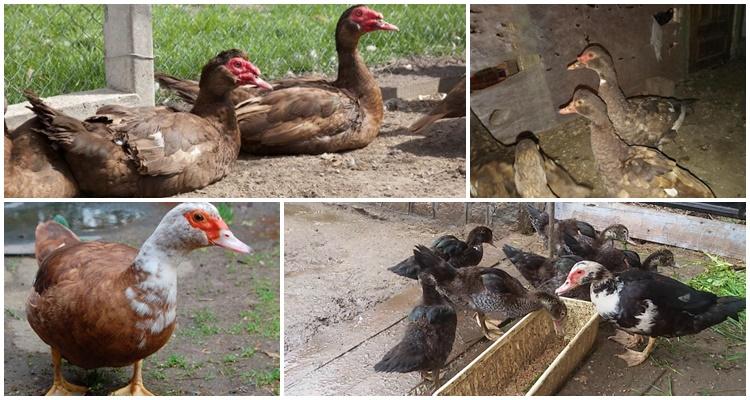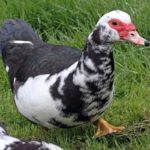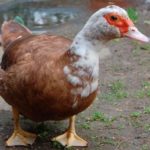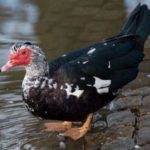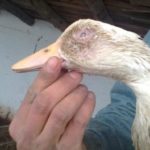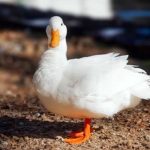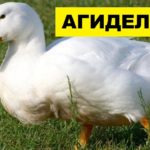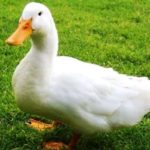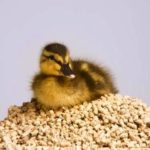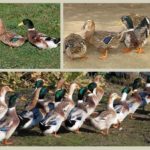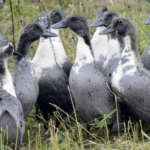In addition to ordinary ducks, musky ducks can be found on poultry farmers' plots. They are popularly called Indian ducks because of the growths on their heads that resemble those of a turkey. In addition to this feature, they have other differences in characteristics from ordinary ducks. Let's consider the description and characteristics of musk ducks, varieties, pros and cons, rules of keeping, feeding and breeding.
History of the origin of the breed
The name “Indoutka” for Muscovy ducks was not coined for nothing.They do somewhat resemble turkeys, but have nothing to do with them. This is not a hybrid of 2 bird species, as some people think. This is a separate species of duck native to South America. Before they were domesticated, they lived there in forests, along the banks of tropical rivers.
Muscovy ducks were exported from South America to Europe and other countries. At first they were kept in parks as an exotic bird, along with swans and peacocks, and then as a common farm bird.
General description and characteristics
The body of Muscovy ducks is long and wide, the neck and legs are short. The wings are developed, the feathers are long, which allows the bird to fly. Drakes and females have red growths on the sides of their heads that secrete fat with a faint musky odor. They are larger in males than in females. Because of these growths, the turkey's head looks like a turkey's.
The species belongs to wood ducks, therefore, unlike domestic ducks descended from mallards, it does not need ponds, but swims well. By nature they are calm and clean, they do not run around the yard and do not create a swamp. They don't quack, but quietly hiss.
Plumage color is white, black with green, black and white, brown, tortoiseshell, smoky. Both males and females of the same breed are colored the same; they can be distinguished by the size of their body and growths. The weight of an adult duck is 2.5 kg, a larger drake is 3.2-3.5 kg (maximum 5 kg). Small ducklings are raised for meat up to 2.5-3 months. During the season, one bird can lay 12 dozen eggs of 75 g each.
Varieties of Muscovy Ducks
The color that Muscovy ducks have in nature is black, interspersed with white areas on the head, neck and throughout the body. The remaining colors were bred by humans.Birds with white plumage also have light, gray-blue eyes. Scarlet growths. The down of ducklings is yellow, white plumage appears after the first moult.
H
Chocolate or brown color is made up of feathers of the corresponding color. There are inclusions of white feathers, ranging from single specimens to white patches on the neck and head. The legs and beak are red, the eyes are brown. The ducklings' down is light brown.
Blue Muscovy Ducks have gray-blue plumage. White areas are present on the sides and wings. The paws are dark gray, the eyes are brown, and the growths are red. The ducklings' down is gray. Regardless of color, musky breed ducks are classified as meat direction.
Positive and negative sides
As you can see, indo-ducks have more advantages than disadvantages.
Conditions and care
Muscovy ducks can be kept with ordinary ducks and with other birds. For living, they can equip any building that will be warm in winter and cool in summer. The birds should feel comfortable and spacious in it; they do not like to live in cramped spaces.
They also don’t like dampness, so the duck house needs to be ventilated every day to remove excess moisture and clean the air.
The growing conditions for musk ducks make it possible to do without a pond. However, it is imperative to walk the bird and not keep it locked up. Movement and sunlight have a beneficial effect on the body, ducks grow better, begin laying eggs faster, and the number of eggs laid increases.
Muscovy ducks are arboreal ducks, so, like chickens, they like to sit on high places. In the poultry house, you can install wide bars for them not far from the floor, at a distance of about 15 cm. The chickens will rest on them.
Below, on the floor, a bedding of straw, peat, and shavings is laid. As soon as it gets dirty, it needs to be changed. At least 2 times a year, the entire room must be disinfected, drinking bowls and feeders - every month. Treatment reduces the likelihood of infection by bacteria and viruses and the subsequent development of diseases.
What to feed?
Muscovy ducks love green food more than ordinary ducks. If possible, they should be allowed to graze. When walking on pasture in the summer, feed costs can be halved. The main diet of Indian ducks is a grain mixture or porridge made from grain cereals, boiled vegetables and root vegetables, and potatoes. As additives, you can add fish and meat and bone meal, feed yeast, salt, and chalk. Indo-ducks can be raised on feed specifically developed for them. Muscovy individuals grow quickly, but slower in relation to ordinary ducks.
In winter, adult birds can be fed (per head) a mixture consisting of 30 g of crushed corn, 20 g of wheat grain, 50 g of barley, 40 g of oats, 15 g of oil cake, 20 g of bran and millet.To the grain add raw, coarsely grated root vegetables, grass cuttings, shells, salt, yeast, fish meal and cottage cheese.
Before laying eggs, musk ducks need to be fed intensively, increasing the number of feedings up to 4 times a day. Usually 3 times a day is enough. In addition to the frequency, you must also follow the feeding schedule, that is, give food at one time, to which the birds get used. Along with feeding the food, you need to change the water in the drinking bowls. Ducks can scatter feed, so feeders should be filled no more than halfway.
Breeding rules
Parental pairs should consist of 1 drake and 2-3 ducks. To produce musk ducklings, purebred parents are selected. If you cross an Indo duck with a Peking duck, you get mulard hybrids. They are superior to their parents in all respects - they are larger, grow faster, lay eggs better, and live longer.
The period of development in a duckling egg is 28 days. The eggs can be hatched by a duck, chicken or turkey itself. If you have a home incubator, hatching will be artificial. When hatching naturally, the ducklings can be left with their mother, but placed separately from other birds so that they do not accidentally injure them. If the ducklings were hatched in an incubator, they are raised in a brooder for a month. The temperature and humidity conditions are set in it - 25-30 ˚С and humidity 60-70%. Ducklings under one month of age should not go into bodies of water; they have not yet developed the secretion of fat, which birds use to lubricate their feathers.
Domestic musk ducklings should be fed boiled crumbly porridge with the addition of herbs, grated vegetables, and dry milk. By 2 months, the chicks reach a weight of 2 kg. If it is necessary to obtain fatty meat, feeding is continued for up to 5 months.
Ducks lay eggs well up to 3 years of age.Then they need to be replaced with young ones. A good adult laying hen can be recognized by a soft and voluminous belly, a wide cloaca, widely spaced flexible pubic bones, and smooth and clean feathers.
Possible diseases
Diseases that can affect Muscovy ducks are divided into 3 groups: infectious, non-infectious and parasitic. The cause of infections is poor poultry care, unsystematic cleaning of the premises, feeders and drinkers, cleaning and disinfection of equipment. Bacteria and viruses enter the bird's body through contact with dirty bedding, eating and drinking from dirty feeders and drinkers.
Parasitic diseases also develop from the owner’s failure to comply with the conditions of keeping and cleanliness in the poultry house. Muscovy ducks become infected with parasites through contact with sick birds. Any disease can be avoided or the likelihood of its development can be reduced if you clean the poultry house and keep the room and equipment clean. Digestive and metabolic diseases are prevented by preparing the correct diet, timely feeding of Muscovy ducks, and providing food in the required quantity.
How long do they live?
Wild ducks live 8-12 years. This is the maximum life expectancy; in reality, many die earlier from disease or predators. Domestic animals raised for meat live up to 3-6 months. Laying hens are left for 3 years, then they are also sent for meat. Breeding drakes can be used for up to 5 years, then they are also changed.
But, if you do not take into account that ducks are used for household needs, then life in a poultry yard is preferable for them than in the wild. If you keep a duck as a pet, it can live the longest possible life.
Muscovy ducks are larger than ordinary ducks and have lean meat. They are calm, do not make noise and do not need a body of water. These are the main advantages due to which they have become popular among domestic poultry farmers. Despite the difference from ordinary ducks, they can be kept and fed in the same way.

